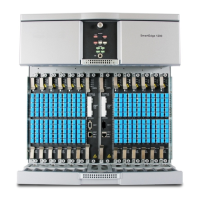External Timing Cables
Cables and Pin Assignments A-3
Ethernet Straight Cable
This shielded cable connects the Ethernet port on a controller card to a LAN hub. Both ends of the cable
are terminated in standard RJ-45 eight-pin modular plugs. Table A-4 lists the pin assignments, which are
for both ends of the cable.
External Timing Cables
An external timing cable provides a connection from an external synchronization source, such as a building
integrated timing supply (BITS) or synchronization supply unit (SSU), to a SmartEdge router. Using two
cables you can connect a SmartEdge chassis to primary and secondary inputs on the external equipment.
Table A-5 lists the cable specifications for the external timing cable.
A cable consists of two individually shielded, twisted-wire pairs: one pair for the synchronization input and
another pair for the synchronization output.
The nominal impedance of the DS-1 wire pairs is 100 ohms; that of the E1 wire pairs is 120 ohms.
One end of the cable is terminated with a DB-9 male connector; the other end of the cable is left
unterminated for attachment to the wirewrap posts of the external equipment. Both of the DB-9 connectors
(PRIMARY and SECONDARY) on the rear panel of a SmartEdge chassis have identical pin assignments.
Table A-4 Ethernet Straight Cable Pin Assignments
# Signal Name Notes
1. Tx (+) –
2. Tx (–) –
3. Rx (+) –
4. – No connection
5. – No connection
6. Rx (–) –
7. – No connection
8. – No connection
Table A-5 Cable Specification for External Timing Cable
Maximum Length
Interface Description Chassis Connectors
1
1. The chassis connectors are on the rear of the chassis.
Cable Connector Feet Meters
External Timing Shielded twisted-pair DB-9 female DB-9 male None –
Note The XCRP and XCRP3 Controller cards can both receive and transmit timing data; however,
the XCRP4 Controller card can receive timing data only. However, the SmartEdge OS does
not support the transmission of timing data to another SmartEdge router or any other external
equipment.

